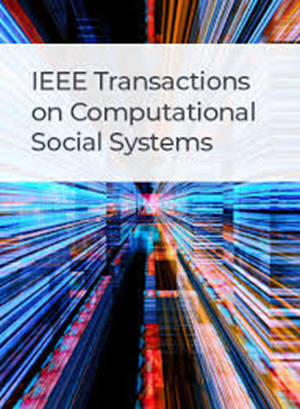基于局部到全局多尺度对比自监督学习的图异常检测
IF 4.5
2区 计算机科学
Q1 COMPUTER SCIENCE, CYBERNETICS
IEEE Transactions on Computational Social Systems
Pub Date : 2024-09-30
DOI:10.1109/TCSS.2024.3457161
引用次数: 0
摘要
图异常检测是图数据挖掘中的一项具有挑战性的任务,旨在识别网络中的非常规模式。近年来,基于对比学习的图异常检测因其对样本不平衡问题具有较高的适应性而受到越来越多的关注。然而,大多数现有工作通常侧重于局部视图的对比,而忽略了全局比较信息,导致性能次优。为了解决这个问题,我们引入了一种新的多尺度对比自监督学习框架,用于图异常检测(GADMCLG)。我们的方法结合了局部级对比,包括节点-节点和节点-子图对比,以及全局级子图-子图对比。前者捕获局部异常信息,而后者旨在捕获全局异常模式。具体来说,我们提出的子图-子图对比采用h阶邻居子图采样,而不是通过边缘扰动增强子图。这种采样策略确保了对目标节点周围邻域的全面观察,从而减少了外来噪声的引入,并为检测结果提供了可解释性。此外,我们还引入了子图集中化技术,以减少子图在属性空间中的绝对位置造成的偏差,从而增强了模型在不同尺度上识别异常的能力。在六个真实数据集上的大量实验结果表明,我们的方法是有效的,并且与最先进的方法相比具有优势。本文章由计算机程序翻译,如有差异,请以英文原文为准。
Graph Anomaly Detection via Multiscale Contrastive Self-Supervised Learning From Local to Global
Graph anomaly detection is a challenging task in graph data mining, aiming to recognize unconventional patterns within a network. Recently, there has been increasing attention on graph anomaly detection based on contrastive learning due to its high adaptability to the sample imbalance problem. However, most existing work typically focuses on the contrast of local views while neglecting global comparison information, leading to suboptimal performance. To address this issue, we introduce a new multiscale contrastive self-supervised learning framework for graph anomaly detection (GADMCLG). Our approach incorporates local-level contrasts involving node–node and node–subgraph contrast, and global-level subgraph–subgraph contrast. The former mines localized abnormal information, while the latter is intended to capture global anomalous patterns. Specifically, our proposed subgraph–subgraph contrast adopts the h-order neighbor subgraph sampling instead of augmented subgraphs through edge perturbation. This sampling strategy ensures a comprehensive observation of the neighborhood surrounding the target node, thereby mitigating the introduction of extraneous noise and providing interpretability for the detected results. Furthermore, we incorporate a subgraph centralization technique to reduce the bias caused by the absolute position of subgraphs in the attribute space, which enhances the model's ability to identify anomalies at different scales. Extensive experimental results on six real-world datasets demonstrate the effectiveness of our method and its superiority compared with state-of-the-art approaches.
求助全文
通过发布文献求助,成功后即可免费获取论文全文。
去求助
来源期刊

IEEE Transactions on Computational Social Systems
Social Sciences-Social Sciences (miscellaneous)
CiteScore
10.00
自引率
20.00%
发文量
316
期刊介绍:
IEEE Transactions on Computational Social Systems focuses on such topics as modeling, simulation, analysis and understanding of social systems from the quantitative and/or computational perspective. "Systems" include man-man, man-machine and machine-machine organizations and adversarial situations as well as social media structures and their dynamics. More specifically, the proposed transactions publishes articles on modeling the dynamics of social systems, methodologies for incorporating and representing socio-cultural and behavioral aspects in computational modeling, analysis of social system behavior and structure, and paradigms for social systems modeling and simulation. The journal also features articles on social network dynamics, social intelligence and cognition, social systems design and architectures, socio-cultural modeling and representation, and computational behavior modeling, and their applications.
 求助内容:
求助内容: 应助结果提醒方式:
应助结果提醒方式:


